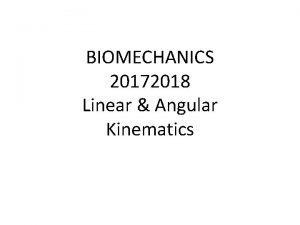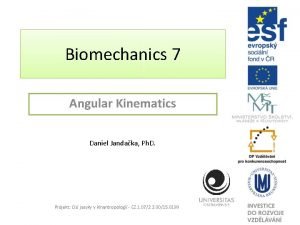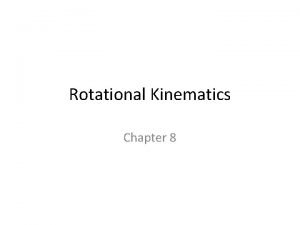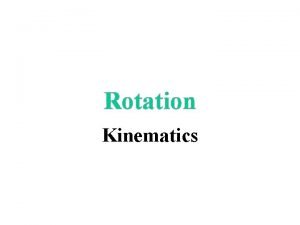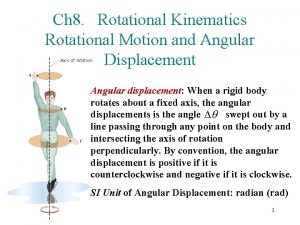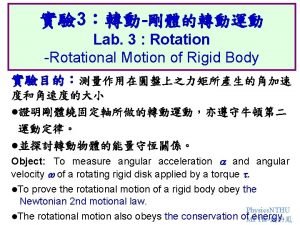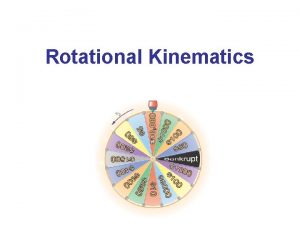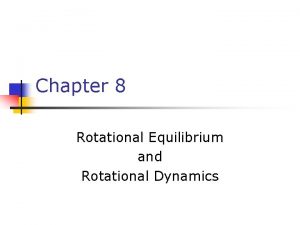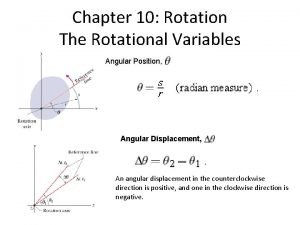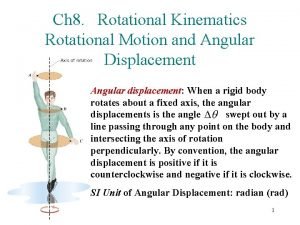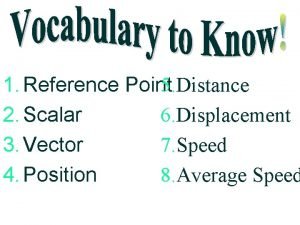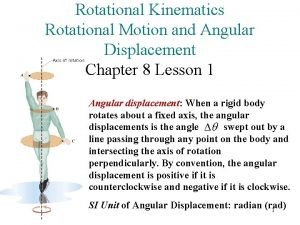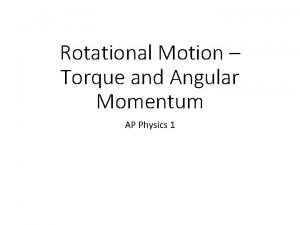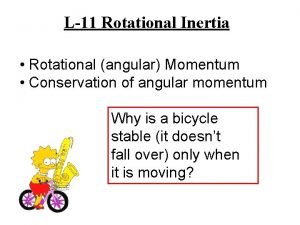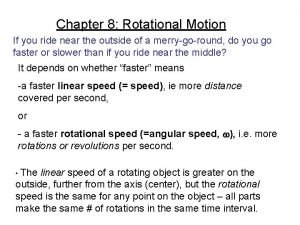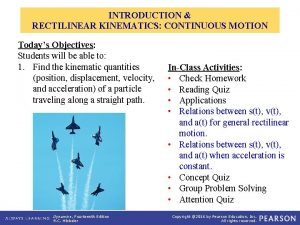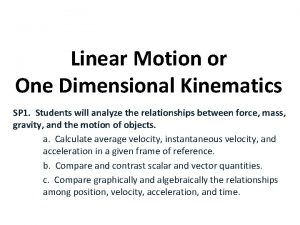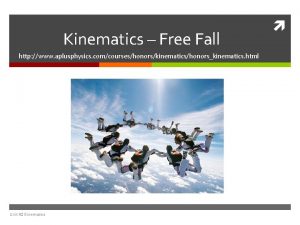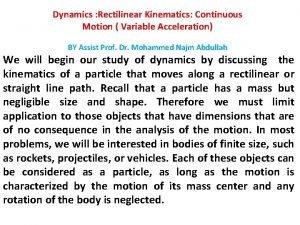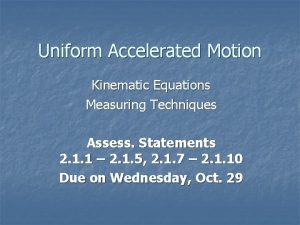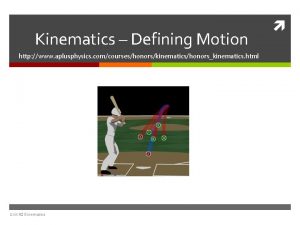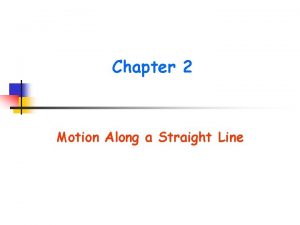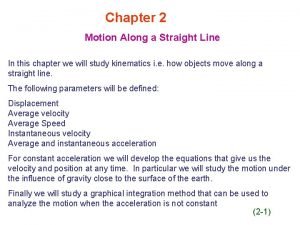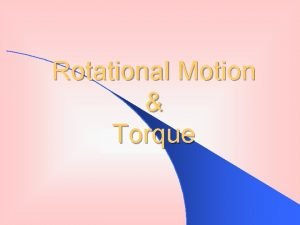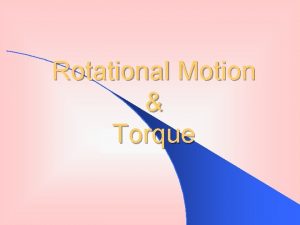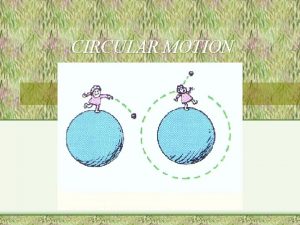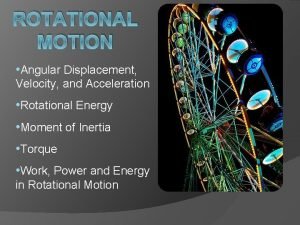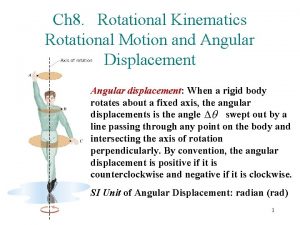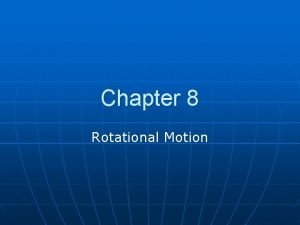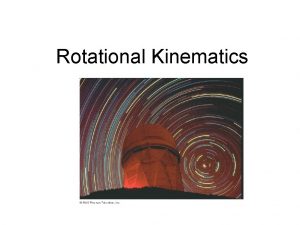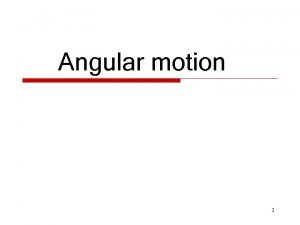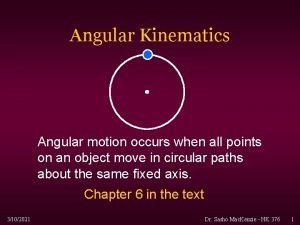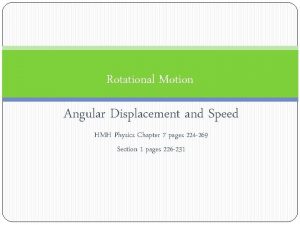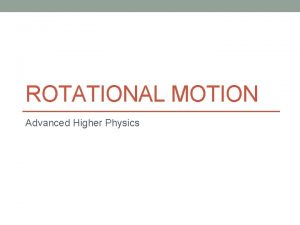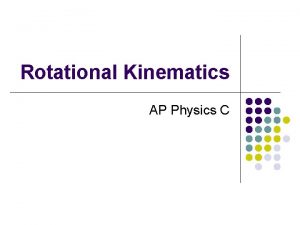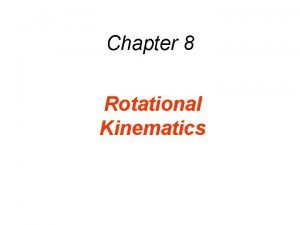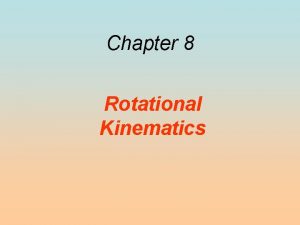Rotational Kinematics Rotational Motion and Angular Displacement Chapter





























- Slides: 29

Rotational Kinematics Rotational Motion and Angular Displacement Chapter 8 Lesson 1 Angular displacement: When a rigid body rotates about a fixed axis, the angular displacements is the angle swept out by a line passing through any point on the body and intersecting the axis of rotation perpendicularly. By convention, the angular displacement is positive if it is counterclockwise and negative if it is clockwise. SI Unit of Angular Displacement: radian (rad) 1

Circular Motion

A Particle in Uniform Circular Motion For a particle in uniform circular motion, the velocity vector v remains constant in magnitude, but it continuously changes its direction.

Angular Position: θ

Angular Position q Degrees and revolutions:

Angular Position q Arc length s, measured in radians:

Angular Velocity w

Sign of

Connections Between Linear & Rotational Quantities

Angular Acceleration a

Angular displacement is expressed in one of three units: 1. Degree (1 full turn 3600 degree) 2. Revolution (rev) RPM 3. Radian (rad) SI unit 11

(in radians) For 1 full rotation, 12

Example 1. Adjacent Synchronous Satellites Synchronous satellites are put into an orbit whose radius is r = 4. 23*107 m. The orbit is in the plane of the equator, and two adjacent satellites have an angular separation of . Find the arc length s. 13

14

Conceptual example 2. A Total Eclipse of the Sun 15

The diameter of the sun is about 400 times greater than that of the moon. By coincidence, the sun is also about 400 times farther from the earth than is the moon. For an observer on earth, compare the angle subtended by the moon to the angle subtended by the sun, and explain why this result leads to a total solar eclipse. Since the angle subtended by the moon is nearly equal to the angle subtended by the sun, the moon blocks most of the sun’s light from reaching the observer’s eyes. 16

Since they are very far apart. 17

18

total eclipse Since the angle subtended by the moon is nearly equal to the angle subtended by the sun, the moon blocks most of the sun’s light from reaching the observer’s eyes. 19

CONCEPTS AT A GLANCE To define angular velocity, we use two concepts previously encountered. The angular velocity is obtained by combining the angular displacement and the time during which the displacement occurs. Angular velocity is defined in a manner analogous to that used for linear velocity. Taking advantage of this analogy between the two types of velocities will help us understand rotational motion. 20

DEFINITION OF AVERAGE ANGULAR VELOCITY SI Unit of Angular Velocity: radian per second (rad/s) 21

Example 3. Gymnast on a High Bar A gymnast on a high bar swings through two revolutions in a time of 1. 90 s. Find the average angular velocity (in rad/s) of the gymnast. 22

23

Instantaneous angular velocity w is the angular velocity that exists at any given instant. The magnitude of the instantaneous angular velocity, without reference to whether it is a positive or negative quantity, is called the instantaneous angular speed. If a rotating object has a constant angular velocity, the instantaneous value and the average value are the same. 24

In linear motion, a changing velocity means that an acceleration is occurring. Such is also the case in rotational motion; a changing angular velocity means that an angular acceleration is occurring. CONCEPTS AT A GLANCE The idea of angular acceleration describes how rapidly or slowly the angular velocity changes during a given time interval. 25

DEFINITION OF AVERAGE ANGULAR ACCELERATION SI Unit of Average Angular Acceleration: radian per second squared (rad/s 2) The instantaneous angular acceleration a is the angular acceleration at a given instant. 26

Example 4. A Jet Revving Its Engines A jet awaiting clearance for takeoff is momentarily stopped on the runway. As seen from the front of one engine, the fan blades are rotating with an angular velocity of – 110 rad/s, where the negative sign indicates a clockwise rotation. As the plane takes off, the angular velocity of the blades reaches – 330 rad/s in a time of 14 s. Find the average angular acceleration. 27

The Equations of Rotational Kinematics 28

To Be Continued… 29
 Aplusphysics kinematics-horizontal kinematics
Aplusphysics kinematics-horizontal kinematics Kinematics
Kinematics Kinematika projekt
Kinematika projekt Rotational motion equations
Rotational motion equations Rotational equations
Rotational equations Angular acceleration unit
Angular acceleration unit Rotational inertia unit
Rotational inertia unit Rotational kinematics equations
Rotational kinematics equations Single displacement vs double displacement
Single displacement vs double displacement Rotational equilibrium and rotational dynamics
Rotational equilibrium and rotational dynamics Rotational equilibrium and rotational dynamics
Rotational equilibrium and rotational dynamics Angular displacement scalar or vector
Angular displacement scalar or vector Angular displacement variable
Angular displacement variable Rotational motion equations
Rotational motion equations Displacement symbol
Displacement symbol Angular displacement
Angular displacement Angular momentum theorem
Angular momentum theorem Rotational inertia symbol
Rotational inertia symbol Chapter 8 rotational motion answer key
Chapter 8 rotational motion answer key Chapter 8 rotational motion
Chapter 8 rotational motion Rectilinear kinematics continuous motion
Rectilinear kinematics continuous motion Example of continuous motion
Example of continuous motion Dot diagram motion
Dot diagram motion Aplusphysics: kinematics-free fall
Aplusphysics: kinematics-free fall Define variable acceleration
Define variable acceleration Rearranging kinematic equations
Rearranging kinematic equations Kinematics of simple harmonic motion
Kinematics of simple harmonic motion Kinematics defining motion
Kinematics defining motion Nvvnn
Nvvnn Motion along a straight line
Motion along a straight line

